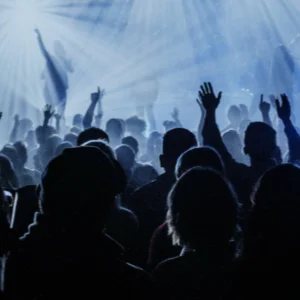The Cure played the Wachovia Spectrum May 10, and for about three hours my life was perfect. Originally scheduled to play Philadelphia way back in September, the group opted to delay its North American tour to work on new material. Allegedly, the group has a double album in the works, but all we got were two new songs, "The Perfect Boy" and "The Only One." While fans may have been peeved that the Cure made them wait almost a full year from when tickets first went on sale, in the end the band put on one of the best concerts I have ever seen.
Stripped down to a four-piece consisting of frontman/guitarist Robert Smith, bassist Simon Gallup, drummer Jason Cooper and returning guitarist Porl Thompson, the band performed sans keyboard, a key element to the group's `80s output. While the shift left some tunes like "Lovesong" slightly lacking, the taught musical focus overall proved invigorating. And despite the guitar/drums limit, the group's show was expansive, with plenty of the brooding and jammy material from albums like Disintegration and Wish thrown in. The band cheated a few times with synth backing tracks, but only a few times.
Clad in black (obviously) and drenched in constantly shifting warm light, the Cure's regular set lasted about two hours, with three encores adding a third hour. The Spectrum isn't really known for having quality sound, but somehow the Cure knew the exact levels needed for their swirling, droning mess of gothic pop. Everything came out clearly, much to the joy of the older members of the crowd. While I noticed a smattering of younger gals spread around the 200 level doing their aimless dancey best, the real heroes of the evening were those who clearly grew up listening to the Cure in the `80s and `90s. I say this because no original Cure fan (in southeastern Pennsylvania at least) can dance. At all. Nor do they care. Mothers embarrassed their daughters with the most freeform expressionistic hand twirls and rump shakes I have ever seen, and it was awesome.
Back to the band. The regular set opened with "Open" and closed with "End," the bookending tracks off of 1992's Wish. In between was a vast mix of songs from the band's nearly 30 years of music-making. Disintegration's "Fascination Street" gave way to Pornography's "A Strange Day." Newer material like The Cure's singles and "Maybe Someday" from the superb Bloodflowers cropped up. Slightly extended takes on "Push" and "One Hundred Years" drew exclamations. Best of all was a one-two shot of "In Between Days" and "Just Like Heaven," perhaps the most perfect combination of pop songs possible. The Beatles can suck it.
New songs "The Perfect Boy" and "The Only One" blended seamlessly with the band's tried-and-true cuts -- think Wish's pop tunefulness with a more restricted approach to jamming -- which is a relief after the ho-hum 2004 self-titled record.
The encores were just as satisfying as the regular set. At 12 songs, one might as well call the show a double set. The first one consisted of "If Only Tonight We Could Sleep" and "The Kiss." A second encore came with "Primary," "Close to Me" and "Why Can't I Be You?". This would have been a respectable finale, even if popular Cure cuts like "Friday, I'm in Love" and "A Forest" were overlooked.
Then came a seven-song third encore of Boys Don't Cry material. It started off with "Three Imaginary Boys," one of the oldest songs in the Cure's cannon. It was a brilliant opening pick, but would we get more old cuts? Was this just a tease? Lesser known songs like "Grinding Halt" and "Jumping Someone Else's Train" were also performed. "10:15 Saturday Night" and "Fire in Cairo" drew a stronger response. The biggest surprises, though, were "Killing an Arab" and "Boys Don't Cry." For a guy who claims to hate "Boys Don't Cry," Smith sure does rock it extra hard live. All of these songs, really, were much more ferocious live than their recordings could ever convey. That the audience never really knew when the set would end added all the more to its enjoyment.
While the night wasn't a sell-out, those in attendance were treated to a brilliant performance by the best gosh dang goth/pop/post-punk/new wave/alternative/huh dja buh huh band of all time. The stage setup added a lot to the show as well. Whether displaying visuals relevant to the songs (Dystopian black and white photos for "One Hundred Years," pictures of lovers for "Pictures of You") or just going all out with the lights (especially during the green and orange sequence for "Wrong Number"), everything was visually perfect for those (by which I mean me) sitting all the way at the other end of the Spectrum.
As for central figure Smith himself, he upped the ante for stadium bands coming through Philadelphia. Sometimes he chugged away at his guitar and sometimes he danced with all the awkward grace of a nervous six-year-old, but he was always entertaining. The members of the Cure do not rely on banter, directionless wankery or "acoustic side stages" to kill time. They plug in, and then they play.
